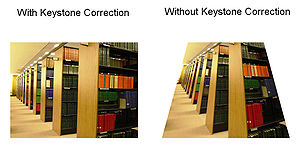
Keystone effect
Encyclopedia

Trapezoid
In Euclidean geometry, a convex quadrilateral with one pair of parallel sides is referred to as a trapezoid in American English and as a trapezium in English outside North America. A trapezoid with vertices ABCD is denoted...
, the shape of an architectural keystone
Keystone (architecture)
A keystone is the wedge-shaped stone piece at the apex of a masonry vault or arch, which is the final piece placed during construction and locks all the stones into position, allowing the arch to bear weight. This makes a keystone very important structurally...
; hence the name of the feature. In the typical case of a projector sitting on a table, and looking upwards to the screen, the image is larger at the top than on the bottom.
Some areas of the screen may not be focused correctly as the projector lens
Lens (optics)
A lens is an optical device with perfect or approximate axial symmetry which transmits and refracts light, converging or diverging the beam. A simple lens consists of a single optical element...
is focused at the average distance only.
Theory
The distortion suffered by the image depends on the angle of the projector to the screen, and the beam angle. The distortion (on a two-dimensional model, and for small focus angles) is best approximated by:
where
 is the angle between the screen axis and the central ray from the projector, and
is the angle between the screen axis and the central ray from the projector, and is the width of the focus.
is the width of the focus.From the formula, it is clear that there will be no distortion when
 is zero, or perpendicular to the screen. See a derivation of this formula at Derivation of the equation to combat Keystone
is zero, or perpendicular to the screen. See a derivation of this formula at Derivation of the equation to combat KeystoneKeystone effect in stereo imaging
In stereo imagingStereo imaging
Stereo imaging is an audio jargon term used for the aspect of sound recording and reproduction concerning spatial locations of the sound source, both laterally and in depth. An image is 'good' if the performers can be effortlessly located; 'bad' if there is no hope of doing so...
, two lenses are used to view the same subject image, each from a slightly different perspective, allowing a three dimensional view of the subject. If the two images are not exactly parallel, this causes a keystone effect. This is particularly noticeable when the lenses are close to the subject, as with a stereo microscope, but is also a common problem with many 3d stereo camera lenses.
Solving the problem
The problem arises for screen projectors that don't have the depth of focus necessary to keep all lines (from top to bottom) focused at the same time. The problem can be solved by:- Move the projector more to the center of the screen, if this does not interrupt vision
- Tilt the screen in a small angle
- Use some type of software on the projector (or computer controlling the projector).
Correction
Keystone correction, colloquially also called keystoning, is a function that allows multimedia projectorVideo projector
A video projector is an image projector that receives a video signal and projects the corresponding image on a projection screen using a lens system. All video projectors use a very bright light to project the image, and most modern ones can correct any curves, blurriness, and other...
s that are not placed perpendicular to the horizontal centerline of the screen (too high or too low) to skew the output image, thereby making it rectangular.
It is often necessary for a projector to be placed in a position outside the line perpendicular to the screen and going through the screen's center, for example, when the projector is mounted to a ceiling or placed on a table top that is lower or higher than the projection screen. Most ceiling-mounted projectors have to be mounted upside down to accommodate for the throw of the image from the lens, with the image rotated right-side-up with software. Keystone correction is a feature included with many projectors that provides the ability to intentionally "distort" the output image to recreate the original rectangular image provided by the video or computer source, thus eliminating the skewed output that would otherwise result due to angled projection.
It is rare for a projector to have the ability to correct horizontal keystoning distortion (too far left or right of the vertical centerline of the screen), although Sony
Sony
, commonly referred to as Sony, is a Japanese multinational conglomerate corporation headquartered in Minato, Tokyo, Japan and the world's fifth largest media conglomerate measured by revenues....
has had capable projectors in its line-up with the feature dubbed Side Shot. Typically this is easily corrected by moving the projector left or right as necessary, or less often by lens shifting.

